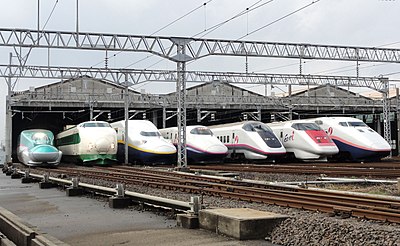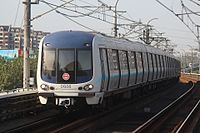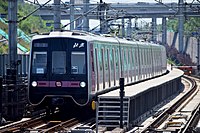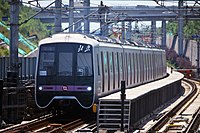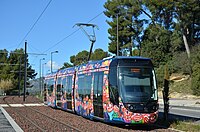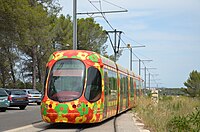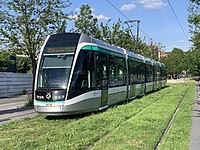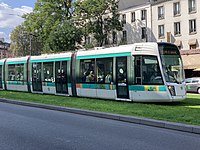United Trenchways: Difference between revisions
| Line 40: | Line 40: | ||
This list represents a comprehensive listing of all rolling stock produced by UT and its subsidiary companies, not necessarily the one UT operates. | This list represents a comprehensive listing of all rolling stock produced by UT and its subsidiary companies, not necessarily the one UT operates. | ||
===High Speed "Shinkansen" Rail lines=== | |||
<gallery> | |||
[[File:JR East Shinkansen lineup at Niigata Depot 201210.jpg|400px|thumb|right|Lineup of United Trenchways-operated Shinkansen trains in Honoda depot, northern Fubini.]] | |||
High Speed railways remain the only major notable example of non-standardised rolling stock in [[Riamo]]. Several attempts have been made since the conception of the initial Standardization Act, but private enterprises as well as multi-lateral competition have turned down all attempts. Trains tend to be between 108 and 144 meters long, with High-Speed trains using letters to help the passengers navigate the lenght of the platforms to help them find their designated seats. | |||
While most high-speed rail lines may share portions of railway with regional and trenchway lines, HSR lines are configured and timed to have absolute priority over other passenger services, as well as cargo ones, across all the national territory. Because of the constricted speed for which some of the older tunnels and bridgeways were built, most high-speed routes can only achieve low speeds in high-speed-rail terms; a condition which has allowed for some older models to remain in operation without becoming deprecated. The constant renovation and repairs of the trains and tracks, as well as the train culture in Riamo, have further prompted older iconic trains to remain in service well past their designed lifespam. | |||
<!--<gallery> | |||
File:Avlo en Miraflores (51070652803).jpg | Avlo A200-L train heading to Miraflores | File:Avlo en Miraflores (51070652803).jpg | Avlo A200-L train heading to Miraflores | ||
File:Italo NVT Class 575 No 575-154 (8614798976).jpg | Italo 550 from UT stopped at Highel in northern Riamo | File:Italo NVT Class 575 No 575-154 (8614798976).jpg | Italo 550 from UT stopped at Highel in northern Riamo | ||
Revision as of 21:33, 7 January 2023
This article is incomplete because it is pending further input from participants, or it is a work-in-progress by one author. Please comment on this article's talk page to share your input, comments and questions. Note: To contribute to this article, you may need to seek help from the author(s) of this page. |
| Predecessors | and more |
|---|---|
United Trenchways, also called UT, is a multinational corporation composed of several infraestructure and transportation builders and operators with hub in Guri. The company was created in 1972 and today encompasses over 54 different societies across many transportation and infrastructure-related fields.
UT originated as one of the many smaller train operators that appeared in Riamo in the late 1890s, and would go on to provide service to many destinations nationwide, later including international routes on its list of clients as public transportation grew larger and larger in the mainland.
The company remains as the largest rail and transport operator and infraestructure builder of Riamo, operating more than 32 urban transportation networks across the country, as well as 2 in Krenya and several minor lines elsewhere, like L-2201 in Kentalis or the Cross-Negro lines to Gavrilia.
Rolling Stock
This list represents a comprehensive listing of all rolling stock produced by UT and its subsidiary companies, not necessarily the one UT operates.
High Speed "Shinkansen" Rail lines
High Speed railways remain the only major notable example of non-standardised rolling stock in Riamo. Several attempts have been made since the conception of the initial Standardization Act, but private enterprises as well as multi-lateral competition have turned down all attempts. Trains tend to be between 108 and 144 meters long, with High-Speed trains using letters to help the passengers navigate the lenght of the platforms to help them find their designated seats.
While most high-speed rail lines may share portions of railway with regional and trenchway lines, HSR lines are configured and timed to have absolute priority over other passenger services, as well as cargo ones, across all the national territory. Because of the constricted speed for which some of the older tunnels and bridgeways were built, most high-speed routes can only achieve low speeds in high-speed-rail terms; a condition which has allowed for some older models to remain in operation without becoming deprecated. The constant renovation and repairs of the trains and tracks, as well as the train culture in Riamo, have further prompted older iconic trains to remain in service well past their designed lifespam.
Short-Distance "Regional" lines
Underground "Subway" lines
Surface "Tramway" lines
